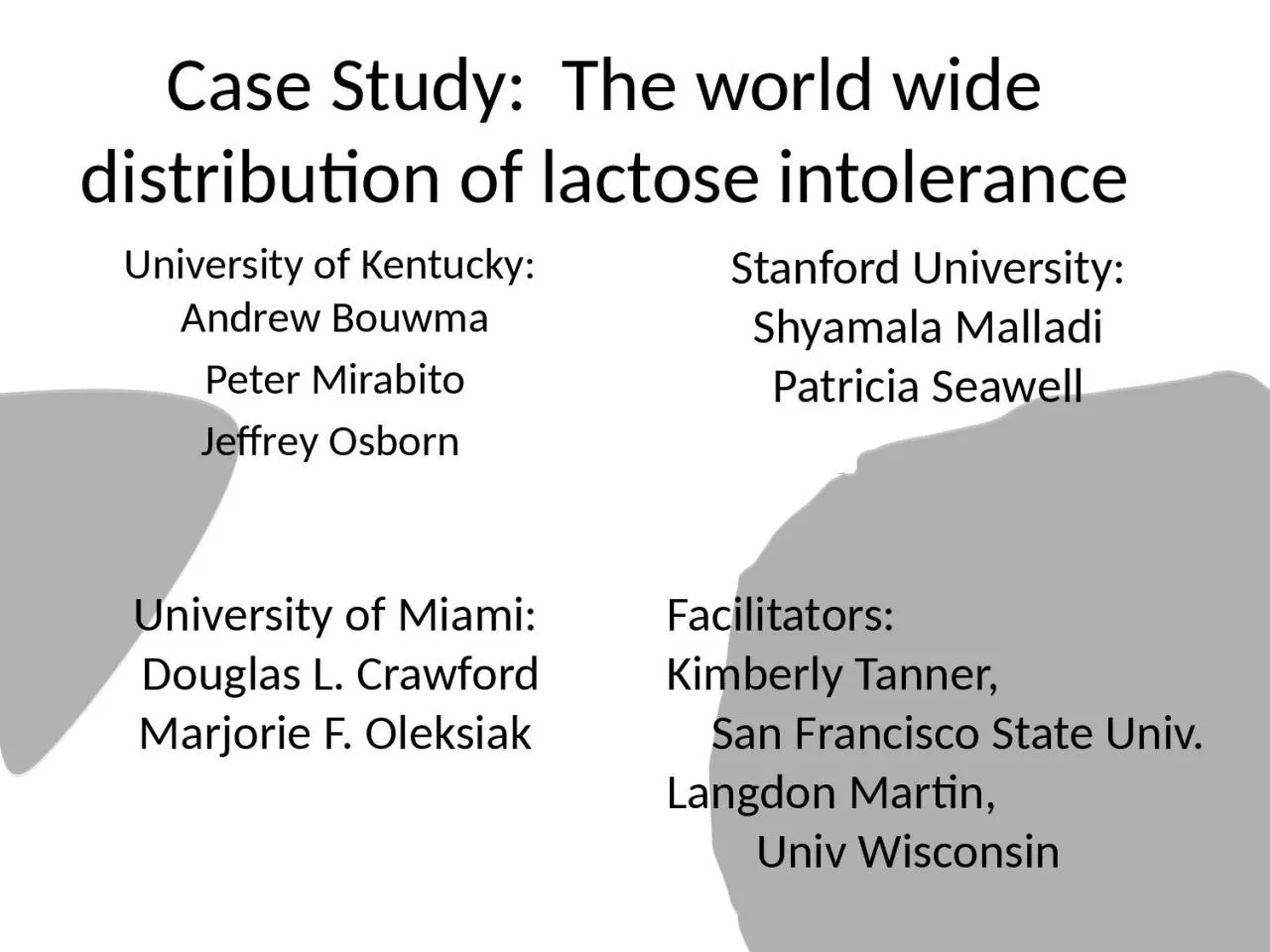

University of Kentucky Andrew Bouwma Peter Mirabito Jeffrey Osborn Stanford University Shyamala Malladi Patricia Seawell University of Miami Douglas L Crawford Marjorie F Oleksiak ID: 929063
Download Presentation The PPT/PDF document "Case Study: The world wide distribution..." is the property of its rightful owner. Permission is granted to download and print the materials on this web site for personal, non-commercial use only, and to display it on your personal computer provided you do not modify the materials and that you retain all copyright notices contained in the materials. By downloading content from our website, you accept the terms of this agreement.
Slide1
Case Study: The world wide distribution of lactose intolerance
University of Kentucky: Andrew BouwmaPeter MirabitoJeffrey Osborn
Stanford University:Shyamala MalladiPatricia Seawell
University of Miami: Douglas L. CrawfordMarjorie F. Oleksiak
Facilitators:
Kimberly Tanner,
San Francisco State Univ.
Langdon Martin,
Univ Wisconsin
Slide2Classroom Setting
Sophomore Genetics Course Students have been introduced to GenesMolecular Mechanisms of TranscriptionTranscriptional RegulationMolecular Mechanisms of TranslationTranslational Regulation
Slide3Learning Goals –
Measurable OutcomeStudents will understandStudents will be able to(1) the concept of a gene- Sketch a representation of a gene and label its parts (promoter, intron, exon, termination signal)
- Relate Mendel’s inheritable traits to a gene(2) the mechanism of transcription
- List, order and define the active players in transcription (or diagram)- contrast the structure of nuclear DNA and hnRNA with cytoplasmic mRNA(3) the regulation of transcription
- how does exercise lead to larger muscle mass
- predict which genes might be expressed under conditions of exercise or hypoxia (low blood oxygen)
- how does eating more sugar lead to more absorption of sugars
(4) the mechanism of translation
- Generate a strip sequence that describes the process/mechanism of translation
- Describe how some antibiotics kill bacteria
(5) the regulation of translation
- compare and contrast global vs mRNA specific regulation
- imagine five ways that protein synthesis can be regulated
(6) how genes affect phenotypes
- explain how skin becomes darker when exposed to the sun
- describe how DNA affects the production of hemoglobin
- - explain why a person of northern European descent can drink milk, while a majority of the world population cannot
(7) and engage in specific components of the scientific process.
- read and interpret
biogeographical
maps
- read and apply appropriate information from the primary literature to a scientific problem or question.
Slide4Learning Goal6) Genotype
Phenotype7) Engagement in the Scientific ProcessOutcomes:Interpret the biogeographical mapsRead and apply appropriate information from the primary literature to address a scientific problem. Students will explain why specific populations maintain the ability to drink and digest milk through adulthood.
Slide5What do you think is the percentage of adults around the world who are lactose intolerant?
A:0-20% B: 20-40% C: 40-60% D: 60-80% E:>80%
Slide6Lactose is milk sugar, a disaccharide in all mammalian milkLactose intolerance is the inability to digest lactose, because of a lack of the required enzyme lactase in the digestive system.
Drinking milk without having an active lactase enzyme produces gastro-intestinal distress (e.g.,diarrhea).It is estimated that 75% of adults worldwide show lactose intolerance.Lactose and Lactose Intolerance
Slide7Adult Worldwide Milk Intolerance
due to the Inability to Digest Lactose
Milk
Intolerance
Adapted from http://en.wikipedia.org/wiki/Lactose_intolerance
Native Americans
Aboriginal Australians
Slide8Adult Worldwide Lactose Intolerance
What do these data say about the worldwide distribution of the ability to drink and digest milk as an adult?Think & Write 1 minutePair-Share 2 minutes
Milk
Intolerance
Slide9Predict
What would you predict is the relationship between the world wide distribution of adult and infant lactose intolerance?A: SameB: OppositeC: UnrelatedD: Same except for North America
Milk
Intolerance
Slide10Discuss Convince your neighbor and revote
What is the relationship between the world wide distribution of adult and infant lactose intolerance?
A: Same
B: OppositeC: UnrelatedD: same except for North America
Slide11What is the relationship between the world wide distribution of adult and infant lactose intolerance?
Frequency of Lactose Intolerance in Infants
>90% Tolerance
Milk
Intolerance
Slide12Brainstorm
Given these data:75% of adults worldwide cannot drink and digest milkYet nearly all infants are able to digest milkPropose molecular mechanisms to explain why only a few populations have the ability to drink and digest milk throughout adulthood.
Slide13Choose a hypothesis
The molecular mechanism that explains why only a few populations have the ability to drink and digest milk throughout adulthood includes variation in:A: the coding region of the lactase geneB: the regulatory region of the lactase geneC: transcription factorsD: the post-translational modification of the enzyme lactaseE: None of the above
Slide14For your final assessment Read the Genetics paper on “Lactose Intolerance”
Write a short essay (250 words) to defend one hypothesis and refute one other > Paper will be posted on Blackboard. > Potential hypotheses will be posted. > Biogeographic map will be posted.
Slide15Diversity: Not using red-green map colors
Population diversity Teaching methods addresses a diversity of learning styles Possible discussion of “Got Milk”Activity/AssessmentTopicTimeClickerThink about people you know who are lactose intolerant1 minute
Map InterpretationAnalysis of biogeographical data2 minutesThink and WritePair-Shore
How much diversity is there in lactose intolerance3 minutesClickerPredict infant milk intolerance1 minute
Clicker
Discuss and revote
2 minutes
Brainstorm and write
Propose
molecular mechanisms to explain lactose intolerance
1 minute
Clicker pre-assessment
Vote
on molecular mechanisms to explain lactose intolerance
1 minute
Final
assessment
Defend and refute hypotheses
Homework